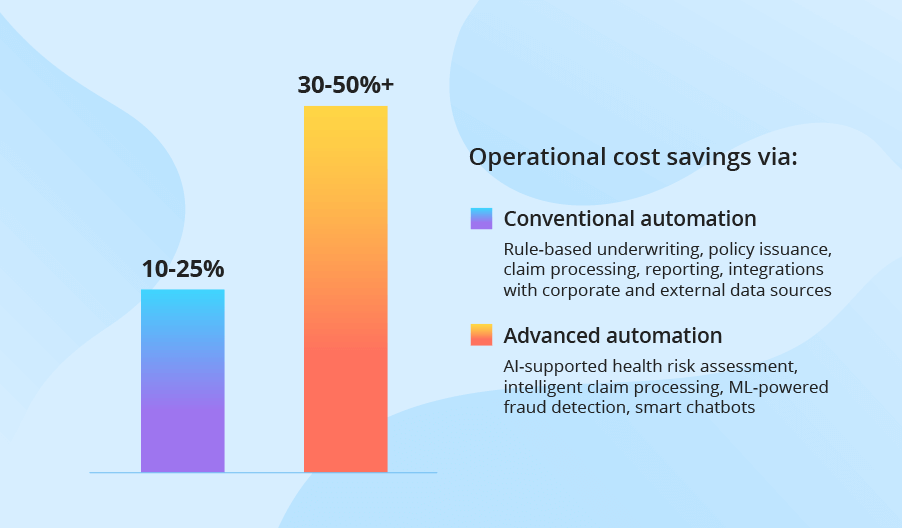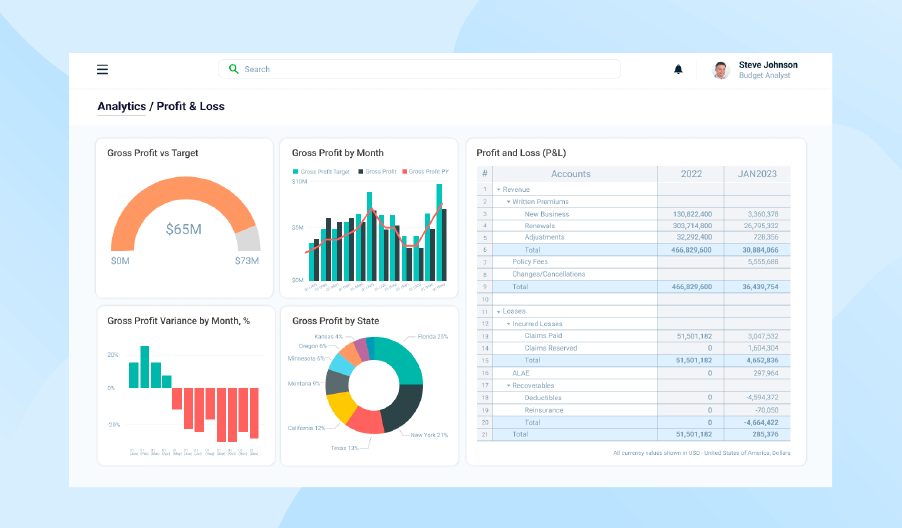Custom Insurance Accounting Software
ScienceSoft applies 18 years of experience in custom accounting software development and 13 years in insurance IT to design robust accounting systems tailored to the unique needs of each particular carrier.
Insurance Accounting Software: The Essence
Insurance accounting software helps insurers streamline workflows across bookkeeping, general ledger management, policyholder billing, capital and claim reserve planning, and disclosure reporting processes. Such solutions automate financial transaction recordkeeping and reconciliation and enable visibility of company-wide cash flows.
Custom insurance accounting software can support specialized accounting calculations (e.g., multi-entity IBNR reserves, fair market value for life insurer investments), as well as multi-GAAP premium and investment income recognition. It can be powered with artificial intelligence to enable data-driven cash flow forecasting. Custom solutions allow direct integration with all relevant financial data sources, enable advanced data security, and simplify compliance with the applicable regulatory and statutory accounting requirements.
Implementation time: 7–15+ months for a custom insurance accounting system.
Development costs: $200K–$600K+, depending on solution complexity. Use our free calculator to estimate the cost for your case.
Annual ROI: up to 290%.
Key Features of Insurance Accounting Software
Below, ScienceSoft’s consultants share a comprehensive list of accounting software features commonly requested by our clients from the insurance domain.
Automated journal entries
- Real-time and batch aggregation of external and intercompany financial transactions: premium payments, claim payouts, investments, etc.
- Automated segmentation of financial transactions (e.g., A/R, A/P, taxes, payroll).
- Automated creation and updating of journal entries on financial transactions in the general ledger and subledgers.
- Customizable journal entry templates for different accounting books.
- Recording and tracking journal entries in multiple currencies.
- User-defined schedules for recurring and reversing journal entries.
- Automated attachment of source documents (customer invoices, premium receipts, claimant checks subject to compensation, etc.) to each journal entry.
- Rule-based GL coding and transaction classification by category (accrued and deferred insurance premiums, claim reserves, investment income, etc.).
- Multi-dimensional chart of accounts (COA) with user-defined dimensions, such as insurance product lines, regions, etc.
- Customizable GL architecture to support complex accounting for multi-entity insurance providers.
- Multi-book accounting for branches and subsidiaries with different functional currencies, account structures, and accounting calendars.
- Rule-based consolidation and reallocation of GL account balances across multiple insurance entities.
- Importing data on personalized insurance premiums and discounts from an underwriting system.
- Invoice generation.
- Customizable invoice templates for various insurance types (health, flood, auto insurance, etc.).
- Calculating and applying region-specific taxes.
- Scheduled and ad hoc invoice sending to customers.
- Processing customer payments via the connected payment gateways.
- Support for multiple payment methods: bank transfer, card, e-wallet, check, etc.
- Real-time invoice tracking by status: sent, received, open, due, etc.
- Automated calculation and monitoring of the received, due, and overdue premium amounts, DSO, A/R turnover ratio, and more.
- Rule-based allocation of received payments to policyholder invoices.
- Scheduled notifications to customers on due premium payments (via a customer portal, email, messaging apps).
- Exporting data on overdue payments to the insurance policy administration system to trigger policy termination.
- (for insurtech companies) Insurance SaaS payment tracking and automated debt collection.
Accounts payable (A/P)
- Importing data on approved claims and due compensation amounts from the claim management system.
- Automated payments to claimants and damage handling service suppliers.
- AI-based suggestions on the optimal payment method and time for each payment transaction.
- Multi-department approval of claim payouts.
- Calculation and monitoring of the amounts owed, paid, DPO, A/P turnover ratio, etc.
Payroll management
- Automated calculation of employee salaries, overtime, bonuses, deductions, reimbursement amounts, etc.
- Recording and tracking the calculated payroll amounts in the payroll ledger and the general ledger.
- Scheduled payments to employees.
- Rule-based calculation and payment of the insurance agent commissions.
Tax management
- Calculating premium taxes, investment income taxes, and other taxes based on the tax rates in the regions of operation.
- Recording and tracking data on the calculated tax amounts in the tax ledger and the general ledger.
- Automated tax filing under region-specific requirements.
- Scheduled tax payment.
Cash flow tracking
- Monitoring real-time cash inflow and outflow, including investment and financing activities.
- Calculating and tracking total debit and credit amounts and cash balances across multiple GL and subledger accounts, books, periods, regions, and entities.
- Cash positioning (daily, monthly, etc.) based on the data provided in bank statements.
Reconciliation and financial close
- Automated reconciliation of bank statements against GL, A/R, and A/P records using RPA and OCR technologies.
- Automated detection of outstanding, duplicate, and inaccurate insurance transaction records.
- Rule-based handling of reconciliation discrepancies (e.g., automatically removing duplicate records or sending the mismatched transactions for manual check).
- Automated intercompany reconciliation for multi-entity insurance businesses.
- Scheduled financial close.
- User-defined financial close periods for entity-specific insurance accounting calendars.
Working capital and reserve management
- Forecasting claim payment amounts (by period, region, insurance type, etc.).
- Calculating and monitoring working capital, quick and current liquidity ratios to plan due payments.
- Rule-based capital reserve allocation for reported claims.
- Suggestions on the optimal working capital reserves to support operational activities and meet claims obligations.
- Short- and long-term liquidity forecasting.
- Automated cash transfer between an insurer’s bank accounts when the liquidity levels exceed or drop below the pre-set limits.
Insurance revenue recognition
- Revenue recognition following user-defined methods:
- Fulfillment of contract method.
- Earned premium method.
- Loss ratio method, and more.
- Configuring revenue recognition methods for short-term and long-term insurance policies, domestic and foreign insurance contracts.
- Forecasting cash flow amount and timing for insurance and investment activities (for individual insurance contracts and contract groups).
- Calculating expected revenue and losses for each insurance policy based on the obligations under a contract, premium and coverage amounts, policy duration, and reinsurance terms.
- Rule-based reinsurance cost allocation to the underlying contracts.
- Configurable triggers (particular dates or cash flow events) to automatically recognize partial premium payments.
- Simultaneously recording premium and investment income transactions in multiple books with various functional currencies and revenue recognition standards, e.g., IFRS 17, AASB 17, Japanese GAAP, etc.
Reporting and compliance
- Automated generation of financial reports (by period, region, insurance product, etc.) in compliance with the global and regional statutory accounting principles (e.g., NAIC Accounting Practices and Procedures for the US) and regulatory requirements, such as IFRS 17, FASB’s LDTI, FATCA, IA and SAMA rules (for the KSA), EIOPA’s Solvency II (for the EU), etc.
- Customizable templates for various insurance disclosure reports, including:
- Premium reports.
- Loss run reports.
- Capital reserve reports.
- Income statements.
- Balance sheets.
- Cash flow statements.
- Tax summaries.
- Configurable reporting periods for various GL books and insurance business entities.
- Consolidated financial reporting for multi-entity insurance companies.
- Scheduled and ad hoc submission of insurance accounting reports to the regulators.
Insurance investment accounting
- Recording and monitoring transactions on investment activities across various asset classes: stocks, bonds, securities, real estate, etc.
- AI-powered calculation of the fair value of investments based on the analysis of market prices for the assets, interest rates, discounting rates, currency exchange rates, and more.
- Automated tax calculation for investment transactions.
- Rule-based recognition of financial gains from investment activities.
- Automated SEC reporting.
Security
- Multi-factor authentication.
- Permission-based access control for various roles: bookkeepers, financial analysts, claim settlement specialists, etc.
- End-to-end data encryption.
- Comprehensive audit trail of user activities.
- AI-based fraud detection.
- Secure document signing using an e-signature.
- Compliance with SOC1 and SOC2, SOX, PCI DSS, NYDFS (for NYC), GDPR (for the EU), and other relevant standards and regulations.
- (optional) Insurance accounting data hashing, timestamping, and recording in the immutable blockchain ledger.





